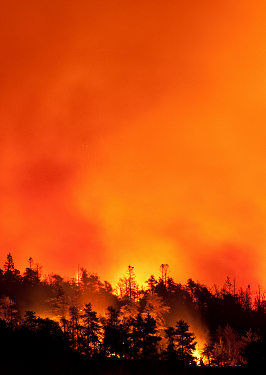In recent years, there has been an alarming increase in the number of wildfires worldwide. According to the United Nations Environment Programme (UNEP), each year between 2002 and 2016, an average of approximately 423 million hectares of the Earth’s land surface burned, an area roughly equivalent to the size of the entire European Union, which became more common in mixed forest and savanna ecosystems.
The global situation
It is estimated that 67% of the annual global area burned by all types of fires, including wildfires, was located on the African continent.
Hazardous weather conditions are projected to become more frequent and intense and last longer, even in areas previously unaffected by fires. Extremely intense wildfires can trigger thunderstorms. This could aggravate fires through erratic wind speeds and generate lightning strikes that start other fires, a rather dangerous feedback loop.
Land use change is another risk factor, including commercial logging and deforestation for farms, grazing lands and expanding cities. Another cause of wildfire proliferation is aggressive suppression of natural fire, which is essential in some natural systems to limit the amounts of combustible material, and inadequate fire management policies.
Effects on Human Health and Biodiversity
Long-term effects on human health extend beyond those fighting wildfires, or those who are evacuated or suffer losses. Smoke and particulates from wildfires have significant health consequences, with impacts often exacerbated among people with chronic diseases, women, children, the elderly and the poor.
UNEP also warns that changes in fire regimes will lead to a massive loss of biodiversity, endangering more than 4,400 terrestrial and freshwater species.
Wildfires generate black carbon and other pollutants that can affect water sources, impact glacier melt, and cause landslides and large-scale algal blooms in the oceans.
The Frontiers Report, published by UNEP, calls for greater investment to reduce wildfire risks; the development of prevention and response management approaches that include vulnerable, rural, traditional and indigenous communities; and further improvements in remote sensing capabilities such as satellites, radar and lightning detection.
Wildfires in Canada, Portugal and Peru in 2024
- Canada
Given the magnitude of last year’s fires, the wildfire season in Canada has not been as devastating this year. However, it has been worse than many people think, Yan Boulanger, a research scientist with Natural Resources Canada, told CBC.
According to the statistics, the 2024 wildfire season is on track to be the second worst in terms of area burned since 1995, with more than 5.3 million hectares burned to date. This is lower than last year, when more than 15 million hectares burned.
As Boulanger warns, the 2024 season is further evidence of what wildfire scientists have observed over the past half-century: a decade-by-decade increase in area burned.
- Portugal
According to Copernicus, the European Union’s Earth Observation Programme, since September, serious forest fires have ravaged northern and central Portugal, affecting more than 10,000 hectares between Porto and Aveiro. More than 5,000 firefighters have been mobilized to fight the blaze.
Local authorities have issued warnings as the risk of forest fires remains high. The fires have caused at least seven fatalities and serious disruptions, including road closures, the destruction of dozens of homes and the closure of schools in several of the affected areas.
- Peru
In recent weeks, Peru has faced a wave of forest fires that have been affecting several regions of the country, mainly in the departments of Amazonas, Ucayali, Loreto and Cusco. These fires, fueled by unfavorable weather conditions, deforestation and inappropriate agricultural practices, have serious consequences for both the environment and the country’s main economic sectors.
According to Infobae, it is estimated that hundreds of thousands of hectares of forest have been consumed by the flames, with human losses and a large number of injuries, affecting areas of high biodiversity in the Amazon and local ecosystems.


